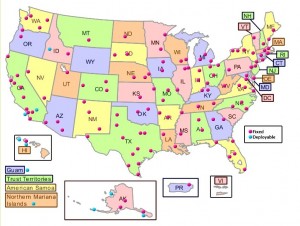Four Sites Where You Can Monitor U.S. Radiation Levels
UPDATED with a fourth site, EPA’s RadNet Lab Open Data system.
Radiation from Japan’s Fukushima nuclear disaster has been detected in the air in five Western states and in rainwater in at least two so far.
While federal officials continue to assure the public that no harmful levels have reached the United States, some Americans have not been content to take the government at its word. Geiger counters have been selling like popsicles in summer, and traffic has never been higher at websites that display data from radiation monitoring stations.
We list three such sites below.
Officials have said Fukushima radiation cannot reach the U.S. without being diluted to safe levels, and that the isotopes detected so far would not be sufficient to bump the numbers recorded on these sites, but should you wish to keep your own eye on things:
EPA RadNet
2013 Update: Both of the links in this section are now out of date. EPA’s Radnet data is now available through this page.
2011 Update: Since the post was originally published, the Environmental Protection Agency launched a new open-data system where it posts laboratory results from its sampling of air, precipitation, drinking water and milk. The new system can be found here: RadNet Sampling Data.
The Environmental Protection Agency’s RadNet system is designed to detect radiation from accidents like the Fukushima disaster in Japan and from foreign nuclear tests. It displays a map of the United States with monitoring stations highlighted. Click on one for a graphic representation of its data.
Last night the graphs were displaying no data—in the wake of EPA’s revelation that radiation had been detected in rainwater. Above empty frames appeared the message, in bold: “To-date, levels recorded at this monitor have been thousands of times below any conservative level of concern.”
But when the system is working, it collects data from more than 140 monitoring stations that sniff the air at three times the rate of normal human breathing. The stations collect particles on filters, analyze their radioactivity and transmit data hourly to EPA, where officials review the numbers and post the graphs online within two hours.
RadNet also issues a daily report, which almost always says, “EPA’s RadNet radiation air monitors across the U.S. show typical fluctuations in background radiation levels. The levels detected are far below levels of concern.”
Nevada Program
If there’s a benefit to having 928 nuclear explosions in your state, it might be having the nation’s greatest concentration of radiation monitoring stations.
A legacy of the Nevada Proving Grounds, Nevada’s radiation monitoring program was reinvigorated after Sept. 11. Operated by the Department of Energy and the Desert Research Institute, the Community Environmental Monitoring Program only covers Nevada and Utah, but it should be of interest to states downwind.
Click on a station for historical results. Click “most recent results” for more detail. While you’re at it you can learn air temperature, soil temperature, barometric pressure, wind speed, wind direction, and more.
The government depends on volunteers—many of them high-school science teachers—to visit its radiation monitoring stations, collect air filters, and bring them in for testing. Thanks to them, Nevadans can keep close watch—with some delay—on radiation levels in the air they breathe.
Unlike the EPA’s system, the CEMP was working last night, reporting detailed readings at levels presumed to be safe.
Radiation Network
Don’t trust the government? Mineralab, a Prescott, Arizona, company that sells geiger counters, maintains radiationnetwork.com, “a nationwide grass roots effort to monitor the radiation in our environment.”
The network collects data from private citizens nationwide who keep their geiger-counters running, with data uploading automatically to the website in real time. The site recently added citizen monitors in Europe and Japan.
The Radiation Network’s map also displays potential sources of radiation across the U.S., including nuclear power plants, testing sites, waste collection facilities, etc.
“Our Monitoring Stations have not yet registered a big, or even perceptibly significant ‘Gamma event’ from any radiation drifting over from Japan, so we can take a little solace in that,” said Tim Flanegin, who operates the site.
“You know, there is an interesting paradox in the field of radiation monitoring. On the one hand, we might use a Geiger counter to perform a radiation scan of a suspected object or situation, and in a weird sort of way, we want a “hit” to confirm our fears, but on the other hand, if we don’t get a detection, some of us are understandably a little disappointed. But in that case, of course, we should instead breathe a sigh of relief.
2013 Forbes.com LLC™ All Rights Reserved
